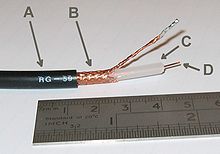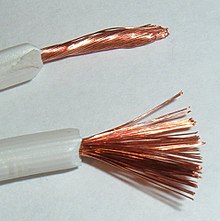|
A wire is a single, usually cylindrical, string of metal. Wires are used to bear mechanical loads and to carry electricity and telecommunications signals. Wire is commonly formed by drawing the metal through a hole in a die or draw plate. Standard sizes are determined by various wire gauges. The term wire is also used more loosely to refer to a bundle of such strands, as in ’multistranded wire’, which is more correctly termed a wire rope in mechanics, or a cable in electricity. Electrical wires are usually covered with insulating materials, such as plastic, rubber-like polymers, or varnish. Insulating and jacketing of wires and cables is nowadays done by passing them through an extruder. Formerly, materials used for insulation included treated cloth or paper, and various oil-based products. Since the mid-1960s, plastic and polymers exhibiting properties similar to rubber have predominated. Two or more wires may be wrapped concentrically, separated by insulation, to form coaxial cable. The wire or cable may be further protected with substances like paraffin, some kind of preservative compound, bitumen, lead, or aluminium sheathing, or steel taping. Stranding or covering machines wind material onto wire which passes through quickly. Some of the smallest machines for cotton covering have a large drum, which grips the wire and moves it through toothed gears; the wire passes through the centre of disks mounted above a long bed, and the disks carry each a number of bobbins varying from six to twelve or more in different machines. A supply of covering material is wound on each bobbin, and the end is led on to the wire, which occupies a central position relatively to the bobbins; the latter being revolved at a suitable speed bodily with their disks, the cotton is consequently served on to the wire, winding in spiral fashion so as to overlap. If a large number of strands are required the disks are duplicated, so that as many as sixty spools may be carried, the second set of strands being laid over the first. 
Coaxial Cable, one example of a jacketed and insulated wire. For heavier cables, used for electric light and power, and submarine cables, the machines are somewhat different in construction. The wire is still carried through a hollow shaft, but the bobbins or spools of covering material are set with their spindles at right angles to the axis of the wire, and they lie in a circular cage which rotates on rollers below. The various strands coming from the spools at various parts of the circumference of the cage all lead to a disk at the end of the hollow shaft. This disk has perforations through which each of the strands pass, thence being immediately wrapped on the cable, which slides through a bearing at this point. Toothed gears having certain definite ratios are used to cause the winding drum for the cable and the cage for the spools to rotate at suitable relative speeds which do not vary. The cages are multiplied for stranding with a large number of tapes or strands, so that a machine may have six bobbins on one cage and twelve on the other. Solid wire, also called solid-core or single-strand wire, consists of one piece of metal wire. Stranded wire is composed of a bundle of small-gauge wires to make a larger conductor. Stranded wire is more flexible than solid wire of the same total cross-sectional area. Solid wire is cheaper to manufacture than stranded wire and is used where there is little need for flexibility in the wire. Solid wire also provides mechanical ruggedness; and, because it has relatively less surface area which is exposed to attack by corrosives, protection against the environment. Stranded wire is used whenever ease of bending or repeated bending are required. Such situations include connections between circuit boards in multi-printed-circuit-board devices, where the rigidity of solid wire would produce too much stress as a result of movement during assembly or servicing; A.C. line cords for appliances; musical instrument cables; computer mouse cables; welding electrode cables; control cables connecting moving machine parts; mining machine cables; trailing machine cables; and numerous others. At high frequencies, current travels near the surface of the wire because of the skin effect, resulting in increased power loss in the wire. Stranded wire might seem to reduce this effect, since the total surface area of the strands is greater than the surface area of the equivalent solid wire, but in fact a simple stranded wire will not improve skin effect since all the strands are short-circuited together and still behave as a single conductor. A stranded wire will have higher resistance than a solid wire of the same diameter because the cross-section of the stranded wire is not all copper, there are unavoidable gaps between the strands (this is the circle packing problem for circles within a circle). A stranded wire with the same cross-section of conductor as a solid wire is said to have the same equivalent gauge and is always a larger diameter. 
Stranded copper wire
From Wikipedia, the free encyclopedia : Manufacture of electrical and electronic cable |



